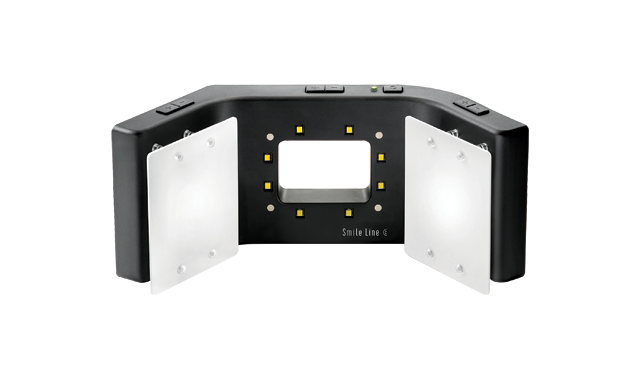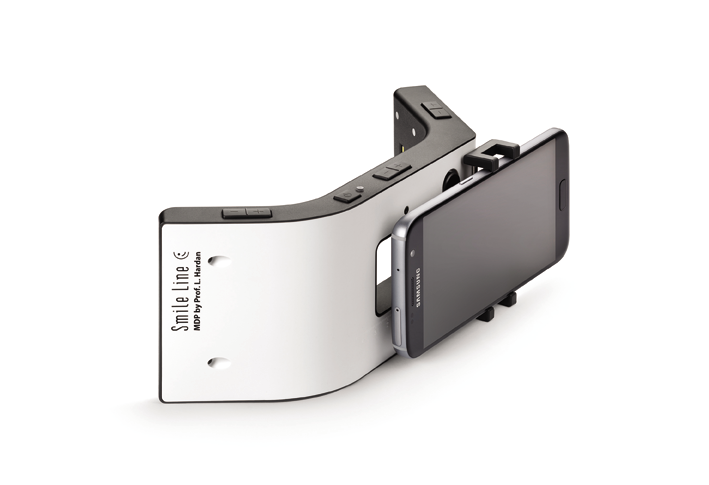Using Smile Lite MDP to take quality photos
How this camera attachment can be used to streamline workflows.

It’s clear that digital Technology makes communication easier in pretty much all aspects of our lives. That’s especially true in healthcare, when sharing patient files and images with healthcare professionals and laboratory technicians is easier than ever before.
Still, sharing an image is not quite the same as seeing things in person, when adjustments can be made to better identify the exact angles and structures that are sometimes lost in the glare of the tooth.
That’s why professor Louis Harden designed the Smile Lite MDP, a camera attachment he hoped would revolutionize dental photography. Instead of purchasing a new professional-grade camera and learning how to take quality photos, the Smile Lite MDP (the MDP stands for mobile dental photography) is designed to attach to one’s smartphone, creating, as he calls it, a “mini photo studio.”
Trending article: 6 stories that prove the dental industry is the weirdest
The attachment looks like a miniaturized version of a photographer’s studio, with its back lights shining at different angles and several bright white lights coming through polarizing filters.
One could imagine that the dentist may start to feel like a professional photographer as he or she learns the ins and outs of the Smile Lite MDP’s different lighting functions. While the central LEDs produce the kind of qualities often achieved in a before-and-after shot, the polarizing filter can be used to help dental technicians see the internal structures of the teeth more clearly than is often possible with a digital SLR camera.

To find out what a dentist thinks about it, we spoke with Marcos Vargas, DDS, a professor in the department of family dentistry at the University of Iowa.
Dr. Vargas uses the Smile Lite MDP in tandem with his digital SLR camera because there’s room for both, he says.
“The Smile Lite is good for people who don’t want to spend a lot of time learning dental photography,” Dr. Vargas says. “For someone who really wants to learn dental photography, I think the DSLR is probably a little more versatile.”
Dr. Vargas finds that using the Smile Lite MDP’s polarizing filters allows him to communicate with his lab more effectively.
“When you look at a normal photo of a tooth, you’ll see a lot of glare and reflection,” he explains. “The beauty of polarized light is that you can remove any glare from the photograph, allowing you to see the internal characteristics of a tooth.
You can see the shape of the dentin and the internal characterization.
“When you’re communicating with the lab, you’re trying to communicate color and the shape of things. Removing the glare with polarized light allows you to communicate to your technician the internal structures that you see in the tooth. When you remove the filter and take a photo with the shade guide, you’re communicating color to the technician.”
Improved communication means a better workflow for the dentist, as well as a better patient experience.
“The patient and the doctor benefit by getting more information to the technician,” he says. “With the Smile Lite MDP, dentists can transmit a lot of information to their technicians when they’re doing crowns that probably allow you fewer remakes. The technician is more likely to produce a more esthetic and accurate product.”
While it does the job well, the Smile Lite MDP is not just for lab communication, Dr. Vargas says.
More from the author: 4 easy ways to get into cosmetic dentistry
“Sometimes when I’m with students, I’ll take the Smile Lite MDP out to teach them a bit,” he says. “We work with crowns, but sometimes we also do direct dressings. When you take photographs with the Smile Lite MDP, you are able to see internal structures that you can replicate when you’re doing direct dressings. It’s good for both indirect and direct restorations.”
Using the two cameras in his practice - his iPhone X with the Smile Lite MDP attachment and his DSLR - allows Dr. Vargas versatility. While the Smile Lite MDP helps him show his laboratory exactly what he sees in his patient’s teeth, the DSLR is capable of capturing multiple images with larger sources of light. He uses those images to prepare lectures and presentations at the university, too.
Dr. Vargas says the beauty of the MDP is that a dentist can work with what he or she already knows and owns.
“It’s more about the practicality of the Smile Lite MDP. You don’t have to learn all about photography to take professional-grade photos with it,” he says.
Product Bites – November 10, 2023
November 10th 2023The weekly new products podcast from Dental Products Report is back. With a quick look at all of the newest dental product launches, Product Bites makes sure you don't miss the next innovation for your practice. This week's Product Bites podcast features new launches from Amann Girrbach, DMG, Pac-Dent, and ASI Dental Specialties. [4 Minutes]